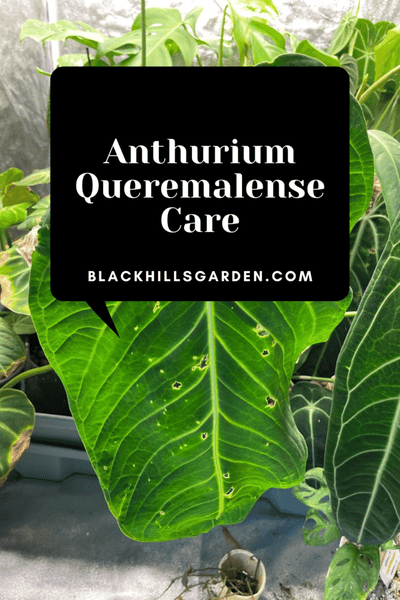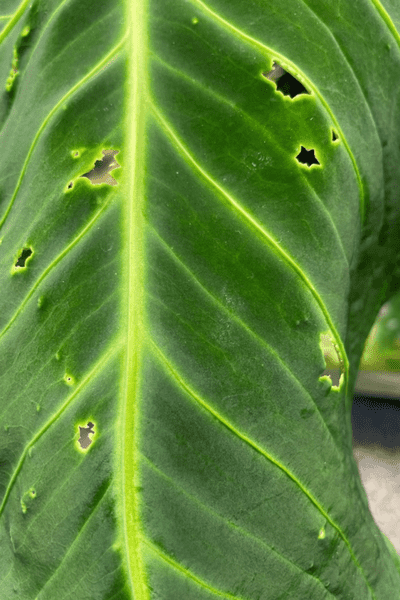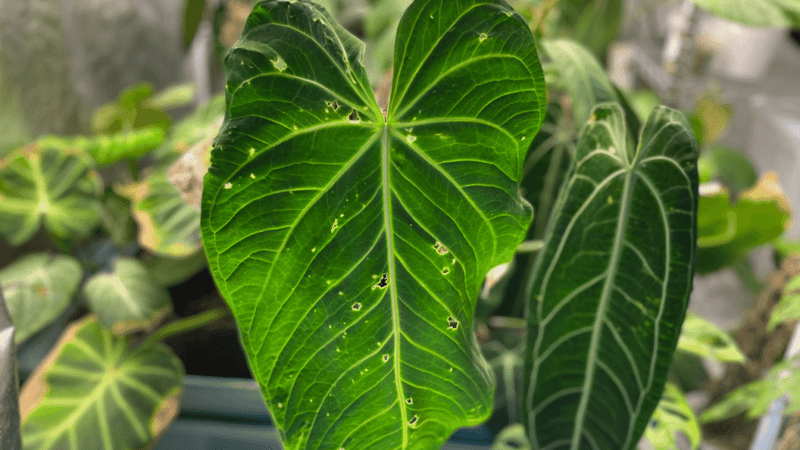Anthurium Queremalense of the genus Anthurium belongs to the biggest genus of the Aroid family.
They are usually found growing in the equatorial region; hence, they persist mostly in the South American countries’ rainforests.
They are also found in the Caribbean, Central America, and most parts of Mexico.
The Anthuriums are one of the most beautiful and uncommon plants in the world.
Although not all plants belonging to this genus produce flowers such as the Anthurium Queremalense, their unique foliage, often having different colored leaves or venation and glossy sides, makes them one of the most sought after houseplants.
Table of Contents
Anthurium Queremalense Care
Anthurium Queremalense is primarily a tropical plant that thrives in jungles. Although they can be grown in homes comparatively easily, they require bright indirect sunlight, moist soil filled with nutrients from the surrounding decaying organic matter, and humid climate conditions.

Anthurium Queremalense Care Guide
Soil
Anthurium Queremalense prefers airy soil with plenty of space to spread its roots. If you are growing this plant indoors, take a large pot with holes at the bottom to drain excess water.
A mix of bark and perlite in your soil would be loved by your plant. This is because Anthurium Queremalense grows in the ground in rainforests, where they are surrounded by trees.
Such a soil mixture would be closest to your plant’s natural habitat.
You can also add substrate to your potting mix. It does not contain any special nutrients.
However, it retains moisture in the soil, and as we will discuss in the next topic, Anthurium Queremalense grows best in moist soil.
Watering
Anthurium Queremalense thrives in moist soil. Their roots are thicker as compared to other Anthurium plants, and they retain water for a longer period and do not get waterlogged easily.
Water your plant every time the top layer of the soil feels dry, which normally occurs every 1-2 days in the right humidity conditions.
You can add substrate to your soil mixture or incorporate sphagnum moss that helps your soil retain water. This will avoid having you to water your plant every other day.
You can also put a layer of living moss on the soil. It will also help retain moisture while at the same time making your plant look pretty indoors.
Living moss not only retains water it also forms a symbiotic association with Anthurium Queremalense. This provides your plant with support to grow.
At the same time, the growth of another plant, i.e., moss near your Anthurium, increases the humidity in the environment, which is beneficial for Anthurium Queremalense.

Light
Anthurium Queremalense growing in rainforests normally have canopy cover over them.
The trees growing thickly around them provide full to partial shade in which the plant has acclimated itself.
When growing this plant indoors, Anthurium Queremalense likes bright, indirect sunlight or a low light situation. Direct sunlight can burn the leaves of this plant.
Temperature
Anthurium Queremalense is a tropical plant. Although it grows in partial shade where it does not get direct sunlight, the humid conditions generally mean they require higher temperatures to grow well.
Day temperatures of 60 to 75 degrees Fahrenheit (16 to 24 degrees Celsius) are ideal for the plant to grow.
Anthurium Queremalense is tolerant to a wide range of temperatures and has been known to survive even in temperatures as low as 40 degrees Fahrenheit and as high as 90 degrees Fahrenheit.

Humidity
Anthurium Queremalense ideally requires humidity of above 80%, such as what it gets in its natural habitat — the rainforest.
This condition is acceptable if you grow this plant in a greenhouse where the requirements can be met through artificial means.
If you are growing this plant inside your house, 80% humidity becomes extreme, and it is not convenient to have the inside of your home so humid.
You can slowly acclimate your tropical house plants to survive and eventually thrive in lower humidity by gradually decreasing the humidity through artificial means.
If you are using a humidifier, you can decrease the humidity (ideally by only 5% at a time).
You can successfully reduce the humidity without harming your plant up to 50%, which is a satisfactory amount of humidity to have indoors.
Humidity is the most important element, as too much or too little can immediately harm your plant.
Fertilizer
Once fertilized, the Anthurium Queremalense starts sprouting larger leaves. It would be best if you use organic fertilizers as only a small quantity of these fertilizers will be sufficient.
Organic fertilizers can be given once a few months, mixed with your soil potting mixture, and they release their nutrients slowly over time.
This prevents your plant from being harmed by excess soluble fertilizer and makes sure the soil remains rich in nutrients for a long time.
You can also use a liquid nitrogen fertilizer if you want, mixing small amounts in the soil every few weeks.

Propagation
Anthurium Queremalense can be propagated using stem cuttings. First, sterilize all your gardening tools to prevent the spread of diseases.
This can be done by dipping your tools in an ammonia mixture. If the tools are made up of stainless steel, you can also place them in boiling water for some time.
Another easy way to sterilize your equipment is to wipe them by rubbing alcohol.
Now, simply take your plant and carefully snip off a few inches of your plant from the stem.
You can place your stem cutting in water for some time until small roots appear before placing them in a pot with a good soil mixture.
Anthurium Queremalense grows slowly, and the new cuttings reach full maturity in several months.
Repotting
The roots of Anthurium Queremalense grow up to be very long and spread easily in their pots. This is why bigger pots are required for their growth.
If your plant has a bigger pot or space to grow its roots, it will grow foliage bigger in size.
Repotting should not be done too often as it weakens the hold of the roots, and the plant becomes unable to support itself and wilts.
Growth and Blooming
This plant grows slowly, especially when it is young. However, once it reaches its full maturity, it starts growing leaves more quickly.
Unfortunately, unlike many other Anthurium species, Anthurium Queremalense does not bloom or give flowers.
However, its beautiful glossy leaves are the reason for its incredible beauty.
Tips to Keep Anthurium Queremalense Problem-free
- Keep a check on your plant’s moisture content as the plant dries out quickly and needs to be kept under constant observation.
- Adding moss to your soil also promotes root and leaf growth.
- Regularly open your windows to allow the circulation of fresh air. It will prevent the growth of pests on your plant.
- Do not prune or repot your plant too regularly as it will weaken its roots’ support and make your plant vulnerable to damage.
- If you are suspicious that your plant may have encountered an infection, immediately isolate your Anthurium Queremalense from any nearby plants to prevent the spread of the infection.
- Sterilize your gardening equipment before and after every use, and do not use the same tool on more than one plant.
- Water your plant less during the winter season as the plant dries out more slowly in low temperature and humidity.
Common Problems with Anthurium Queremalense
- High humid conditions such as required by this plant also promote pests and other diseases that thrive in wet and humid climates.
- Very low humidity levels can cause your plant to wilt within a few hours.
- While watering your plant, ensure that it does not get too much water on the leaves, as many bacteria can travel in the water and infect your plant.
- Excessive artificial fertilizer or with high nitrogen content can burn the leaves of your plant.
Pests and Diseases
Anthurium Queremalense can normally resist pests quite well and better than most other plants; however, they are prone to diseases.
Their humid conditions and requirement for constantly moist soil often lead to them succumbing to harmful diseases.
Anthurium is most commonly susceptible to bacterial and fungal infections that also thrive in high humidity.
Bacterial blight, fungal leaf spots, root rot, and stem rot are the most common problems affecting this plant.
Bacterial Blight
Bacterial blight is most commonly caused by the Xanthomonas bacteria in Anthurium plants.
These bacteria enter the plant through their natural pores (such as hydathodes) or through wounds the plant gets through plucking, pruning, or when insects puncture the plant.
The disease starts showing visible symptoms when the bacteria have usually multiplied for a long time.
Bacterial blight is categorized by chlorosis or yellowing of the leaves and dead necrotic patches in a V-shape at the tips of the leaves.
If the bacterial infection is not controlled in time, the leaves wilt and eventually die.
- The first and foremost step you should take when you see an infection is to isolate that plant from the rest of your vegetation. This will prevent the spread of that infection, so it does not harm any more of your plants.
- Cut off any leaves even if they are slightly affected.
- Use any bactericide, preferably containing copper, to spray sparingly on your plant. It will kill the bacteria but will not heal the spots on the leaves. After treating your plant, you will have to carefully prune it to go back to its healthy self and not leave behind a trace of infection.
- To prevent bacterial infections, keep ventilating the area where your plant is kept.
Root Rot
Plants requiring moist soil usually have problems pertaining to root rot. Anthurium Queremalense is a plant that requires constantly moist soil.
If it is overwatered, which happens too often under the care of inexperienced plant growers, the roots of the plant develop this fungal disease caused by the growth of Rhizoctonia.
This fungus thrives in wet soil, sucking off the nutrients from the plant. Eventually, the young roots become weak and waterlogged, which affects the plant’s overall growth.
If left untreated, Rhizoctonia can spread and attack the stems and leaves above the ground.
To control root rot, carefully replace the entire soil.
Let the roots of your plant dry out before repotting it in a bigger pot with a new soil mixture.
Frequently Asked Questions about Anthurium Queremalense Plant Care
My Anthurium Queremalense has crisped leaves and is showing stunted growth. How can I fix this?
When these two symptoms show up together, it means your plant is probably not getting enough humidity. If you are growing the Anthurium Queremalense indoors, use artificial methods to increase the humidity, it will gradually reverse the effects.
Why are the leaves of my Anthurium Queremalense burning?
Often the leaves of this plant burn when you give them too much fertilizer that contains nitrogen.
Why are the leaves of my Anthurium Queremalense yellowing and just dropping off?
If the temperature in which your plant is growing becomes too low (below 50 F or 10 C), they start showing such symptoms.
Conclusion
A recently discovered plant, the Anthurium Queremalense has made itself a popular plant in indoor horticulture in a very short time.
Its long, dark, and glossy leaves that grow up to be five feet long and two feet wide, coupled with the fact that they can be grown easily by an inexperienced person, make it a highly sought-after ornamental plant.

